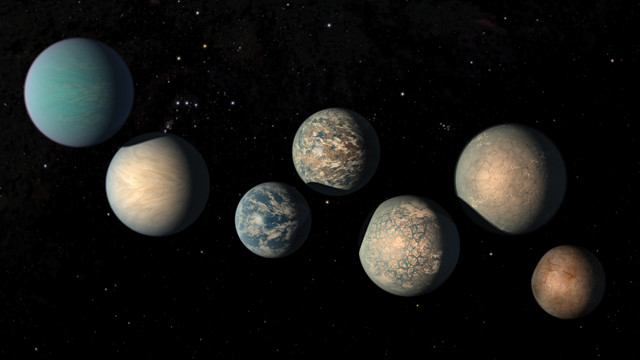
by Rory Barnes Tuesday, July 3, 2018

Some of the seven planets in the TRAPPIST-1 system may host oceans. If they are present, ocean tides could alter the planets' rotational and orbital properties in measurable ways. Credit: NASA/JPL-Caltech.
Because life on Earth requires liquid water, many researchers searching for extraterrestrial life — one of science’s most enduring and provocative quests — are focused on finding and characterizing oceans on alien worlds. In recent years, astronomers have identified exoplanets that are Earth-sized and receive about as much light from their host stars as Earth does from the sun. These two factors — optimal size and illumination — are the most fundamental requirements for a planet to have a liquid water ocean. But while substantial research efforts have been expended to explore how host stars, other nearby planets and atmospheric compositions affect exoplanet habitability — and some scientists have begun to think about the role of exoplanet interiors — there has been almost no investigation of oceanographic properties of exoplanets and how they may impact habitability. Earth’s oceans significantly affect our planet’s surface and atmospheric properties — as well as its rotational and orbital properties — and they do so in measurable ways. Hence, the time has come for astronomers and physical oceanographers to begin discussing how models of terrestrial oceans can be applied to oceans beyond our solar system.
Centuries of astronomical and oceanographic observations, better understanding of physics, and, more recently, precise global-scale satellite altimetry data reveal, among other information, where and how land-ocean interfaces and seafloor topography modify tidal flows. These advances have contributed to substantial understanding of oceanographic behavior on Earth. The gravitational pulls of the moon and the sun perturb Earth’s shape such that our planet is not a perfect sphere. Rather, because lunar and solar gravity tug at Earth unevenly — pulling more strongly at parts of the planet that are closer to the moon or the sun, respectively — the planet’s shape is slightly distorted. As Earth rotates, its surface spins through this equilibrium shape, so the slight bulges induced by these gravitational forces aren’t fixed in place, but instead move across the surface. Oceans and land are both affected by these forces, but while solid land resists deformation more strongly, waves are created in the oceans. The height of the ocean as a function of latitude, longitude and time is due to this tidal deformation, as well as to local seafloor topography, Coriolis forces, weather, local deep-sea currents (which themselves are influenced by complex continental shapes), locations of straits, and even volcanic eruptions. And the height of ocean waves as they hit seashores is determined by ocean tides and the shape of the shallow seafloor offshore.
Can this fundamental knowledge inform studies of potential oceans on planets beyond the solar system? Astronomers such as myself have extrapolated from what we know about Earth to show that planetary rotational periods can become synchronized with orbital periods, resulting in “tidal locking”; that orbital shapes can become more circular and distances to host stars can shrink; and that tidal heating can become substantial. These processes all affect how — and how much — tidal energy is imparted to a planet, thus affecting its habitability. But we don’t know how these factors may apply for planets experiencing tidal forces markedly different than those on Earth. And what about planets with different continental configurations, or with oceans much deeper than our own?
In many cases, potentially habitable exoplanets orbit very close to their host stars, often accompanied by other nearby planets — these conditions raise the possibility for strong tidal deformations. TRAPPIST-1 is perhaps the paradigm for this class of exoplanetary system, with seven planets — some of them potentially ocean-bearing — all orbiting a relatively cool red dwarf star at distances far less than Mercury’s orbital distance from the sun. The presence of oceans on these or other worlds is purely speculative today, but if they are present, ocean tides could alter the planets’ rotational and orbital properties in measurable ways.
In 2020, NASA will launch the James Webb Space Telescope, humanity’s first telescope capable of detecting potential signatures of life beyond the solar system by studying exoplanet atmospheric compositions with spectroscopic measurements. (It may even be able to detect the glint from exoplanet oceans!) From these observations, plus knowledge of a planet’s host star, the planet’s orbit and rotational properties, and the configuration of neighboring worlds in the system, astronomers and astrobiologists can assess the likelihood that a given exoplanet hosts life.
To realize the goal of finding life in the universe, it is imperative that astronomers leverage the vast knowledge that terrestrial physical oceanographers have acquired. Connecting astronomers and oceanographers is no simple task, however, because of the compartmentalization of scientists into hyperspecialized disciplines. Specialization has led to incredible advances across numerous fields, but the scientific challenge of discovering extraterrestrial life cannot be confined to a single discipline; it lies at the intersection of many disciplines, and we need groups of scientists with broad knowledge bases. Oceanographers who seek new challenges must reach out to astronomers, and vice versa, to develop a generation of “physical exo-oceanographers” empowered to help critically examine the fundamental question: Are we alone in the universe?
© 2008-2021. All rights reserved. Any copying, redistribution or retransmission of any of the contents of this service without the expressed written permission of the American Geosciences Institute is expressly prohibited. Click here for all copyright requests.